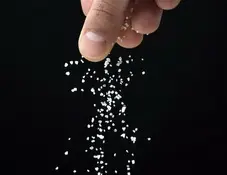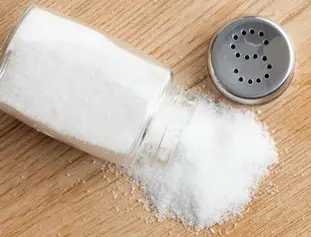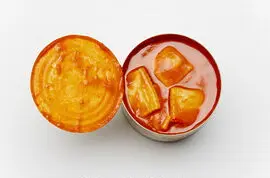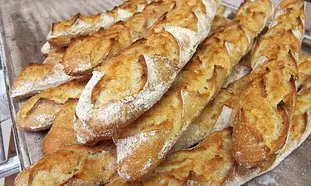This site uses only a few technical cookies necessary for its operation. By continuing to browse, you accept their use.
To find out more...
To find out more...
Let's go easy on the salt

In terms of cooking, I'm probably not teaching you much, salt is ubiquitous, we put it in almost all our dishes, in varying amounts depending on our taste, some like salty, others less, others still not. Its main role is the flavor, the taste, we say that it is a flavor enhancer, ie it reveals the tastes of food, especially if they are a bit bland by nature.
8,564 4.8/5 (19 reviews)
Keywords for this post:SaltHealthExcessWHOLimitationReductionLast modified on: February 20th 2021
Let's go easy on the salt
In other words, a dish that is not salty is much less tasty than a salty dish, and as a result, it is, for many (and I am the first), difficult to do without it.
But there are 2 salts, the one you add while cooking, or by spreading with semi-salted butter, according to your taste, and especially the one you don't see or don't feel, the hidden salt. And to illustrate this, I will take 2 concrete examples:
So when you heat up a simple box of ravioli, you will eat too much salt without realizing it, and as a recent study by "Que choisir" shows, it's even worse for anything that seems cheap, the less expensive the product is, the more salt it contains, so that the manufacturer can mask the poor quality of its ingredients.
But let's go back to salt, in France, the usual use (but it is not regulated, for the moment), is 18 gr of salt per kilo of flour. This is relatively little, to compare 50 years ago it was 24 gr, or even more!
The trend is clearly downwards, and the bakery industry is pushing for a reduction to 16 or 14 g, or even less.
Moreover, there is a simple phenomenon linked to slow bread-making: the longer the dough rests and ferments, the less salt it needs. And so the express baguettes from the supermarkets or bread factories, imagine what they load in salt to try to sell you something that has a vague taste.
Don't hesitate to ask your baker, ask him how much salt he uses per kilo of flour? If he's a good baker, not only will he give you a straight answer, but he'll also be able to give you his personal perspective on this delicate subject. By the way, our Belgian friends have a maximum of 14g.
Then, when we cook, we must try to avoid having a heavy hand in salt with extremely simple tricks too: always taste before re(salting), prefer spices to salt when possible, do not "double" that is to say for example do not salt a dressing, because it is already salty with the addition of mustard, no or little salt if you put cheese in your recipe, etc.
Nothing revolutionary in all this you will have understood, you just have to be a little careful, read carefully the labels of what you buy, and especially... cook as much as possible!
To sum up: Let's go easy on the salt, it's a matter of our health.

But there are 2 salts, the one you add while cooking, or by spreading with semi-salted butter, according to your taste, and especially the one you don't see or don't feel, the hidden salt. And to illustrate this, I will take 2 concrete examples:
Ready-made meals
The industrialists of the food industry have found in salt their best friend, not only they raise the taste as I told you previously, but moreover it acts as a water retainer, so everything that contains water, almost everything in fact, is generally very or too salty. Tragically, there is a lot of it everywhere, in all ready-made meals, cold cuts, snacks... even sweet foods (creams, desserts, biscuits, etc. etc.) contain it.
So when you heat up a simple box of ravioli, you will eat too much salt without realizing it, and as a recent study by "Que choisir" shows, it's even worse for anything that seems cheap, the less expensive the product is, the more salt it contains, so that the manufacturer can mask the poor quality of its ingredients.
Bread
In bread, there is also salt, bread is extremely simple: water, flour, a little salt and yeast or leaven, period! Everything else, as JP Coffe rightly said, is crap, just there to compensate for the deficiencies of industrial bread.
But let's go back to salt, in France, the usual use (but it is not regulated, for the moment), is 18 gr of salt per kilo of flour. This is relatively little, to compare 50 years ago it was 24 gr, or even more!
The trend is clearly downwards, and the bakery industry is pushing for a reduction to 16 or 14 g, or even less.
Moreover, there is a simple phenomenon linked to slow bread-making: the longer the dough rests and ferments, the less salt it needs. And so the express baguettes from the supermarkets or bread factories, imagine what they load in salt to try to sell you something that has a vague taste.
Don't hesitate to ask your baker, ask him how much salt he uses per kilo of flour? If he's a good baker, not only will he give you a straight answer, but he'll also be able to give you his personal perspective on this delicate subject. By the way, our Belgian friends have a maximum of 14g.
And so?
The observation is without appeal, we eat too much salt, we should be at 5 gr/day maximum according to the WHO, and we are rather at 10/15 gr in France.What can we do?
The solution is almost too simple: first of all, we must try to limit all ready-made products, which is often easier said than done. Let's see this as a strong signal to push us to cook more and more ourselves, by transforming the products we buy locally. The virtuous circle I've already told you a lot about (yes, it's my hobby): we buy local even if it's a bit more expensive, we support local producers, they produce well and healthily, it's good for our health, everyone wins.Then, when we cook, we must try to avoid having a heavy hand in salt with extremely simple tricks too: always taste before re(salting), prefer spices to salt when possible, do not "double" that is to say for example do not salt a dressing, because it is already salty with the addition of mustard, no or little salt if you put cheese in your recipe, etc.

Nothing revolutionary in all this you will have understood, you just have to be a little careful, read carefully the labels of what you buy, and especially... cook as much as possible!
To sum up: Let's go easy on the salt, it's a matter of our health.
Lasts posts
Butter vs. grease
We often read in a recipe where a pastry is put into a mould that, just before pouring, the mould should be buttered or greased. But what's the difference between these 2 terms?December 1st 20256975
Getting out of the fridge early
Very often when you're cooking, you need to take food or preparations out of the fridge, to use them in the recipe in progress. There's nothing tricky about this: you just take them out of the fridge and use them, usually immediately, in the recipe. But is this really a good method?November 24th 20259735
Who's making the croissants?
When you look at a bakery from the outside, you naturally think that in the bakery, the bakers make the bread, and in the laboratory, the pastry chefs make the cakes. It's very often like that, with each of these professions having quite different ways of working, but sometimes there's also one...November 23th 2025872
Oven height
When we put a dish or cake in the oven, we naturally tend to put it on the middle shelf, and that's what we usually do. But in some cases, this position and height can be a little tricky, so let's find out why.October 8th 20252,4805
The importance of sieving
In recipes that use a fine powder (flour, powdered sugar, etc.), you'll often see the advice to sift before using it. To sift is to pass the powder in question through a sieve (a very fine strainer) before incorporating it into your recipe. It's often advice, but is it really useful?September 3rd 20257,3583
Other pages you may also like
Fruits and their syrup
As I write these lines, we are finally in the summer, the holidays are approaching, and above all, the fruits are pouring onto the market stalls, if they are ripe, it's time to enjoy them to the full! .July 24th 201911 K4.7
Perpetual stock
It's something you have probably have done yourself: cooked or pre-cooked vegetables before adding them to a recipe. This is almost always done the same way: peel the chosen vegetables (carrots, for example), cut them up, boil them in salted water (using a tablespoon or so of coarse salt per litre),...November 22th 201631 K5
Foie gras service
For the upcoming christmas meals you too may be sacrificing to the tradition of foie gras? If so, I suggest you take a look at everything that revolves around serving foie gras: how to serve it, and what to eat and drink with it.December 23th 201716 K4.9
Fats for cooking
If you need to fry or sear anything a frying pan or saucepan, the temperature is likely to be high. In particular, I have cooking red meat in mind. In this case, what should fat should we use? And at what temperature?January 23th 201821 K5
The golden-brown finish on puff pastry
Let's take a look at the tricky matter of producing puff pastry with an attractive, golden-brown finish. French pastry chefs call this "dorure" (literally, "gilding"). Behind this quirky term there lurks a real problem (and the solution): when using puff pastry (pâte feuilletée) for a pie, or...February 8th 201847 K 24.6
Post a comment or question
Follow this page
If you are interested in this page, you can "follow" it, by entering your email address here. You will then receive a notification immediately each time the page is modified or a new comment is added. Please note that you will need to confirm this following.
Note: We'll never share your e-mail address with anyone else.
Alternatively: you can subscribe to the mailing list of cooling-ez.com , you will receive a e-mail for each new recipe published on the site.









